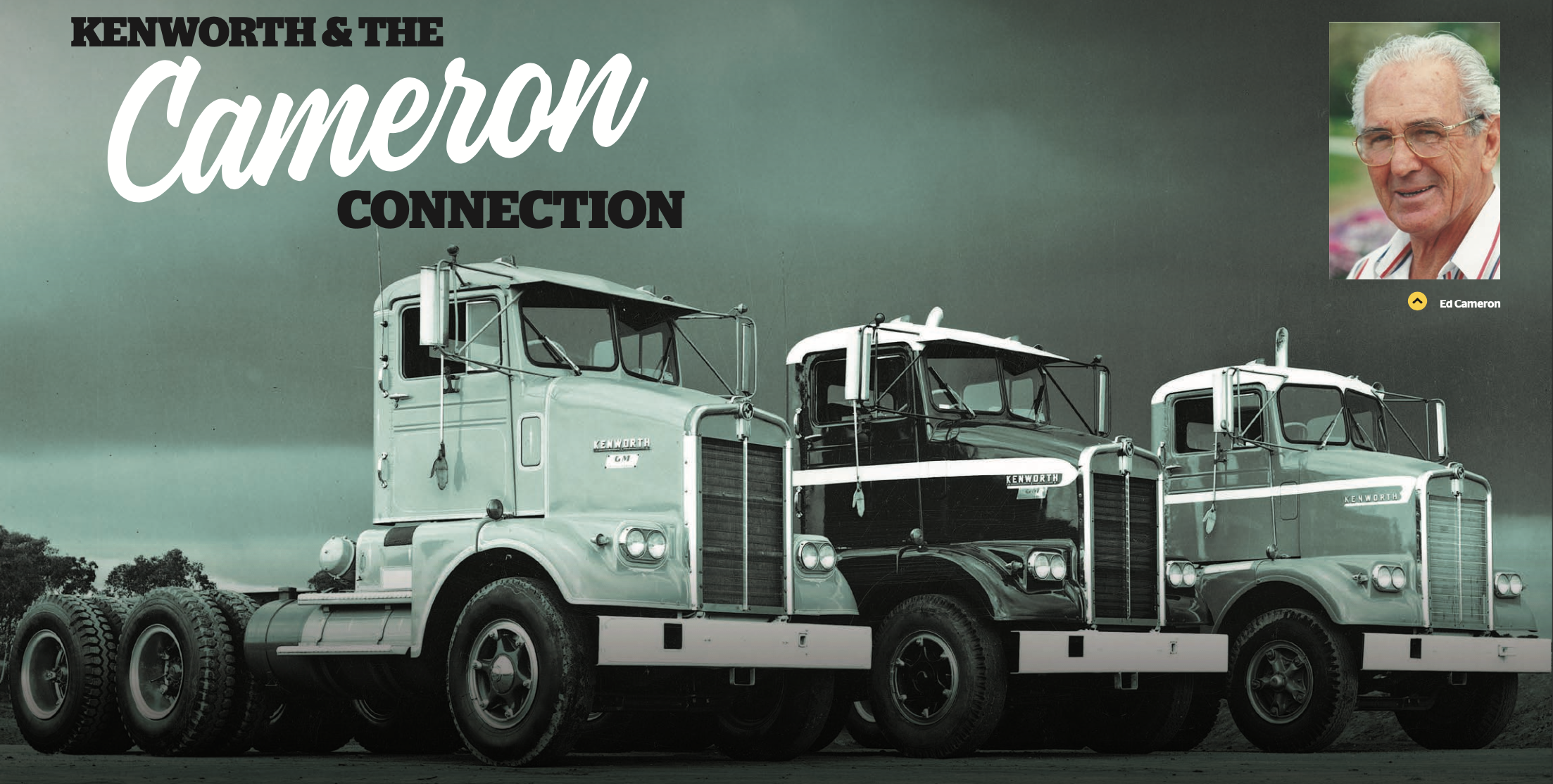Kenworth & The Cameron Connection
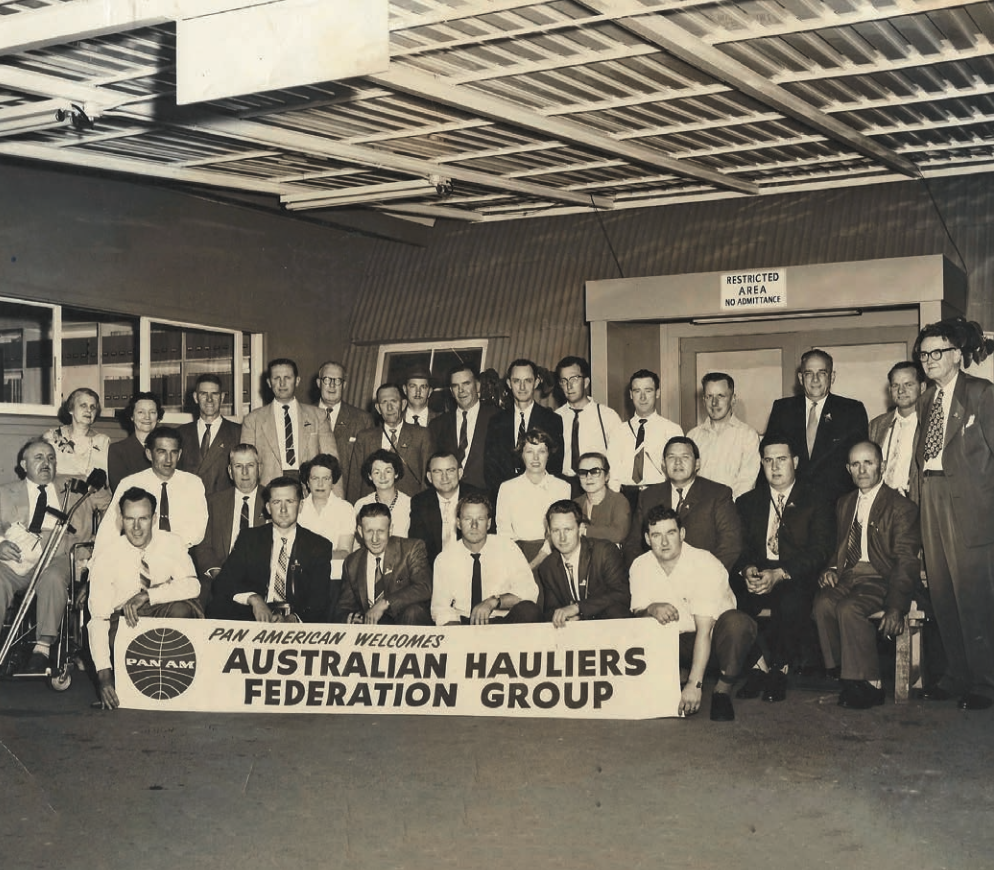
Among the annals of Kenworth’s Australian history, there is no greater contributor to the brand’s foundation than the late Ed Cameron. But what drove this enterprising Victorian truck operator to seek something better and, in the process, create the platform for such a stellar future? Perhaps the best answer is to be found in a 1984 interview, long after his retirement, revealing the resolve of a man who truly believed in ‘havin’ a go’.
It’s early July and the half-yearly sales figures for 2021 have just been issued.
In the heavy-duty class, Kenworth is king by a country mile. Again! Still! Yet, in many ways, and despite the seemingly unrelenting interruptions and difficulties of a bludgeoning pandemic, Kenworth’s latest figures are just another notch in a year of notable notches. A year, for instance, celebrating 50 years of manufacturing Kenworth trucks – more than 70,000 of them – at Paccar Australia’s Bayswater (Vic) headquarters.
In another part of Melbourne, though, July 2021 is a sad and solemn time for one particular family. Sure, the sadness and solemnity are soothed somewhat by feelings of immense gratitude and pride, but it’s a month that nonetheless marks the passing five years earlier – on July 16 – of family patriarch and Kenworth founding father Ed Cameron at the grand age of 93.
There was, however, far more to Ed than being the instigator of the first import of Kenworth trucks to Australia. Much more! For starters, he was the father of Glen Cameron, whose high profile transport and logistics operation is widely regarded as being among the most professional in Australia. Like his father, though, Glen’s start in the trucking industry in 1975, at just 22 years of age, was both modest and unspectacular, built on little more than the staunch belief that dedication and service were the keys to ultimate success.
Intent on doing his own thing, his own way, and sourcing little more than advice from the family archive, it is an equally resolute Glen who declares the values and determination of his father as the guiding principles that have seen his business evolve into a national company with more than 1,000 pieces of equipment and major logistics and warehousing facilities.
Consequently, and deservedly, the desire to preserve his father’s legacy runs deep and strong in Glen, and while much of Ed’s initiative in laying the foundations for Kenworth’s future in our part of the world is formally recorded in the brand’s history books, it is, perhaps, easy to overlook the operational factors that encouraged Ed and others to look beyond the status quo.
Who better to tell the story of this bygone, yet hugely formative, era, though, than Ed himself?
TOUGH START
Fortunately, the late Geoff Johnson, chief editor of the once-esteemed industry magazine Truck & Bus Transportation, interviewed Ed for the January 1984 issue about a decade after he’d handed over control of D & E Cameron Transport, the business formed with his brother Don. What follows is a moderately edited version of that insightful interview.
“When I was demobbed from the army in 1946,” Ed started, “I was living in the Doncaster-Templestowe area of Melbourne, then given over to fruit orchards.
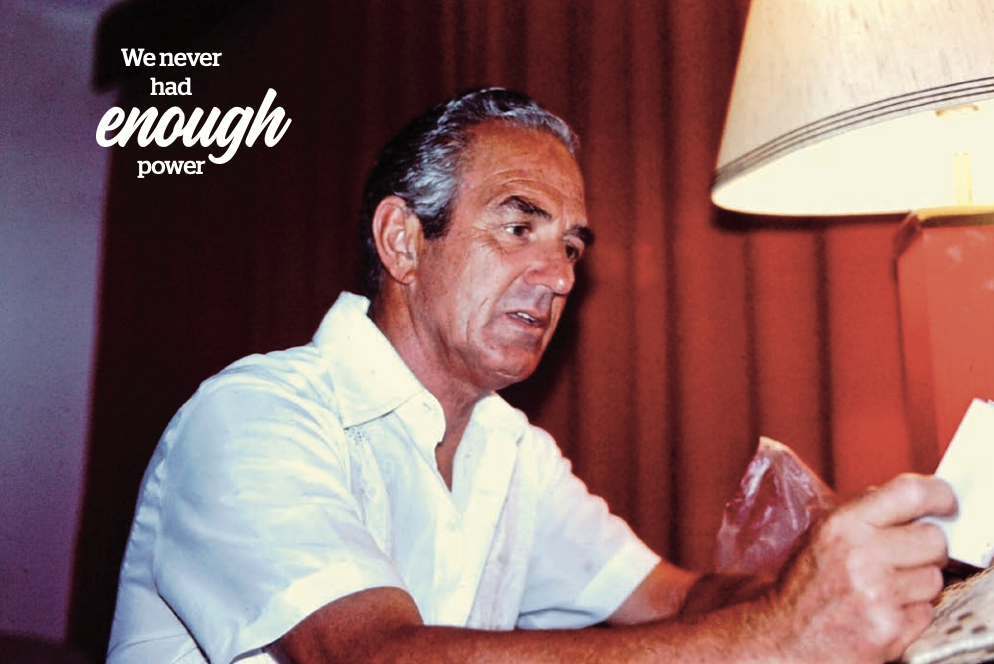
“My dad had been running a truck for many years and my brother and I could see an opportunity to try and make some money, hauling locally-grown fruit to the Melbourne markets. We bought dad’s truck, a 1935 Dodge, for 150 pounds ($300), went into business and, shortly afterwards, sold the truck for 300 pounds ($600). Our first profit, you could say. We then purchased our first new truck, a 1946 Dodge five-tonner.
“During market days in Melbourne, George Blomfield, who carried fruit from Mornington Peninsula to the Victoria Market, and myself, discussed the prospect of transporting and selling fruit and vegetables on the Sydney Growers market.” Back then, the NSW and Victorian rail systems ran on different gauge widths and, as Ed remarked: “Because of strikes and damage caused with the rehandling of fruit at Albury, there was a great opportunity to establish a profitable operation.”
So, one cold June morning in 1946, George and Ed set off for Sydney in George’s 1938 Federal Diesel loaded with cases of apples and Brussels sprouts. A couple of blown tyres and 24 hours later, they arrived in Sydney markets and proved their idea was good, but the truck and roads were lousy.
Even so, as Johnson reported, they soon started a weekly service to Sydney, serving the Thursday morning market and loading general goods on the return trip. However, after a couple of trips, the crankshaft broke and the Federal was replaced with a K5 International powered by a GMC 36hp (27kW) petrol engine from army disposals, coupled to a round-nose 24ft (7.3 metre) McGrath trailer, also from army supplies.
Although the K5 performed reasonably well, they had real trouble with overheating, so they developed a system of engine cooling that had to be seen to be believed. At the front of the trailer they mounted a 44 gallon (200 litre) drum of water connected to a half-inch (12mm) rubber hose to a pump mounted on the passenger’s side floor, then to the radiator, returning through the overflow pipe and attached hose to the 44 gallon drum.
With two drivers, the passenger would operate the pump when needed, which was often when travelling between Tarcutta and Yass in summer months.
They kept this up for six months, doing one round-trip per week, until early in 1947 when the Cameron brothers bought a new Reo, soon after adding an International and some tray trucks to the fleet.
Ed took up the story again, introducing Kenworth to the discussion for the first time. “Over the next few years, we built up the business, which was then trading as D & E Cameron Transport Pty Ltd, with an assortment of trucks and trailers, but we were constantly plagued by mechanical problems.
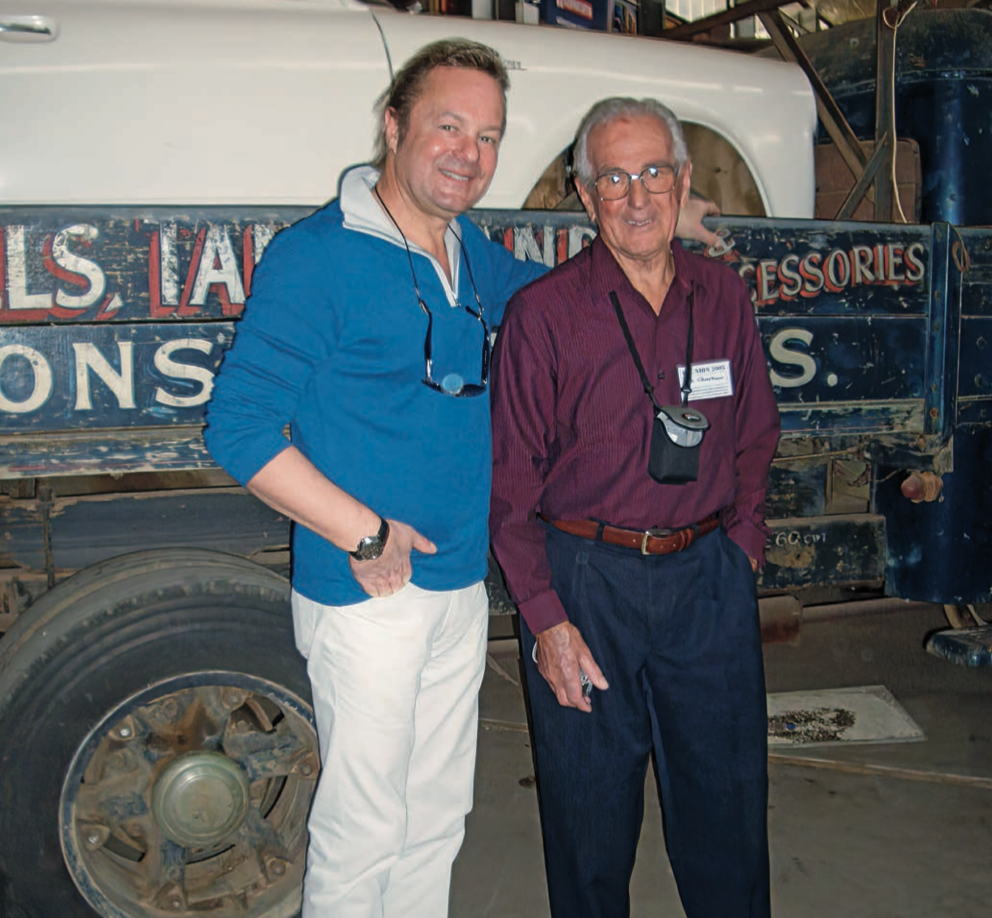
“We never had enough power for the demands of interstate haulage; there was never enough braking and manufacturers’ reliability was almost a joke. We had made enquiries with local suppliers to see if they would bring out better designed trucks from the United States, to no avail. So, in 1955, we went to the USA to look over the market.
“International Harvester was only interested if we would place a big order for 50 or so units, but we only had 12 trucks in the fleet, so we decided to just plod on with what we had.
“We were very impressed with what Kenworth had to offer but import quotas and dollar restrictions made it impossible to continue negotiations. Everything we looked at indicated American custom-built trucks would be ideal for Australia.
“I returned to the USA in 1959, as a member of a delegation from the Australian Hauliers Federation and, while there, talked to the Kenworth people again. By this time the import position was better and they decided in 1960 to give it a go.
“Two top executives from Kenworth came out to Australia and I travelled with them to survey the market and interview operators in Victoria and New South Wales. We ordered seven Kenworths – three for George Blomfield and four for us – but at least it was a beginning.
“We set up a company called Australian Kenworth Truck Sales (AKTS) Pty Ltd to distribute the models nationally, established outlets in Melbourne and Sydney, and appointed Brown & Hurley as Queensland dealers.” (It’s worth noting that 2021 also marks Brown & Hurley’s 75th year in business, but it was largely Ed who first convinced Alan Brown and Jack Hurley of Kenworth’s potential in Australia.)
By this time, things were moving quickly for Ed and Kenworth as his faith and confidence in the brand’s future picked up pace. “We bought land at Doncaster and built an assembly and servicing centre,” he continued.
“The initial vehicles came in fully assembled and, shortly after, we did partial Australian components supply and then went into assembly of CKD [completely knocked-down] units.” By this stage, though, trucks weren’t the only things on Ed’s mind.
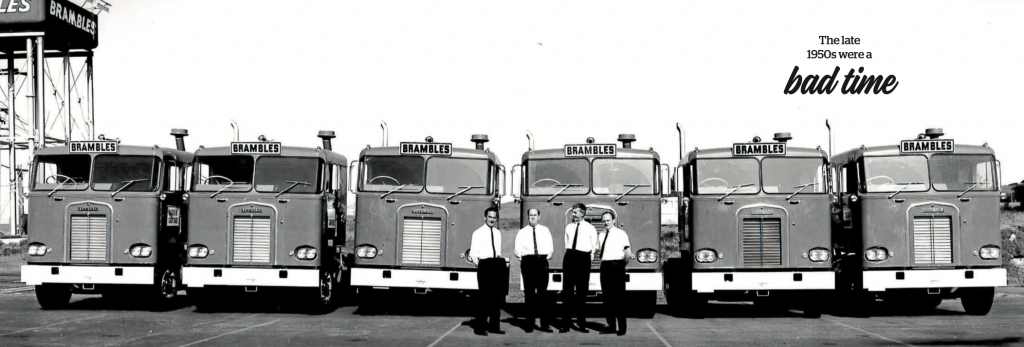
TRUCKS, TRAILERS AND TRUCKIES
“Kenworth re-engineered their ‘S’ model with a 90-inch [2,280mm] BBC – bumper to back- of-cab – for right-hand drive and we offered Detroit Diesel 6V71 and 8V71 power with 12-speed Spicer transmission and Timken rear axles.
“The long nosed 120-inch [3,050mm] BBC was then engineered in right-hand drive, followed shortly after by the 52-inch and 76-inch [1,320 and 1,930mm, respectively] cab-over units, each one being properly engineered and set up for Australian conditions.”
Such was the brand’s burgeoning success, however, that Ed recognised that the time had arrived to move aside.
“We continued to import and sell Kenworths until 1967, when we could see that the operation was getting too big for us. So, we talked to Kenworth in America and they agreed to open their own subsidiary in Australia, taking over what we had begun in 1961. “They set up Kenworth Trucks Australia and built a new plant and headquarters in Bayswater.
“I stayed with them for several years and helped in the establishment of sales, marketing and distribution divisions. By that time, Kenworth had penetrated most aspects of heavy haulage in Australia, so I decided to ease out and return to running trucks, not selling them.”
In what was obviously a reflective moment, Ed told Johnson: “It’s interesting to look back on those pre-Kenworth days. In 1962, Leyland and AEC and Albion models held about 60 per cent of the 40hp (30kW) and over diesel market. These, and other English-built trucks, were not originally designed or engineered for Australian conditions, while Kenworth had engineered its ‘S’ series for use out here, before putting it on the Australian market.”
But, as Ed then pointed out, Kenworth’s interest was perhaps fortuitous. “I believe if International or other distributors had brought in larger models, they would have stood to make a killing in Australia.
“As it was, the only trucks gearing up to give the Leyland group a run for its money was Atkinson, which later was taken over by International, and Mack, which had a good market in Queensland and the Northern Territory.”
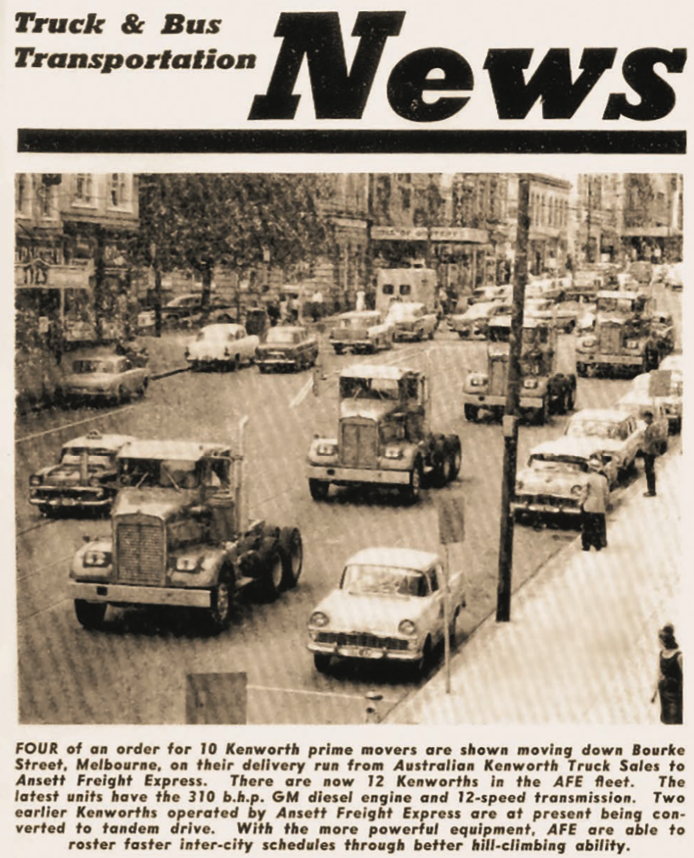
Kenworth’s ‘Write’ Stuff
Truck makers aren’t always impressed with the truck media, particularly if there’s a difference of opinion regarding the virtues or otherwise of some practices or products. Kenworth – or rather, Paccar Australia – is no exception.
However, in Kenworth’s formative years in Australia, one truck magazine played a crucial role in actually educating and informing truck operators about this newly- arrived American brand’s attributes.
First published in 1936, Truck & Bus Transportation magazine was an industry tome with a powerful and influential following. By the turn of the century, though, fierce competition, questionable management and a departure from the genuine journalism, which had given the publication such valuable credence, saw the magazine slide sadly into oblivion.
In its post-war heydays, though, Truck & Bus and its long-serving, highly respected chief editor Jack Maddock were vital allies in the advancement of Australian road transport, and Ed Cameron knew it.
As he told Maddock’s successor, Geoff Johnson: “During the initial introduction of Kenworth we found Australian truckies had no knowledge of the custom-built trucks of the USA, other than Mack and White.
“Kenworth and Peterbilt were almost unknown. Jack Maddock came to the party and regularly published pieces explaining these vehicles and their performances.
“He believed in what we were doing and saw the importance of heavier, more powerful and safer trucks in this country. He used Truck & Bus to further operators’ knowledge of these vehicles [and] I can’t speak too highly of Jack’s help.”
However, American trucks weren’t his only interest. “By 1958,” he told Johnson, “we were building our own trailers in Doncaster, using a fabricated suspension similar to Fruehauf equipment, which we found to be superior to what was available at that time.”
Given the brand’s growing reputation here, Fruehauf’s American masters decided to set up an Australian arm and, as Ed explained: “Their first products included an insulated van body when other trailer manufacturers were only offering flat-tops and tankers. We were carrying a lot of semi-perishables and were looking for a unit of this type.
“We already knew of Fruehauf in the States, so decided to buy the first unit off the local assembly line [and] this was the first of many Fruehauf trailers for our business.”
Yet, despite the emergence of better products, the trucking industry had other issues, which caused Ed to become heavily involved. “The late 1950s were a bad time for small fleet owners and owner-drivers,” he recalled. “We were assailed by all the state governments wanting to clap heavy road maintenance taxes on interstate operators.
“Every one of these imposts had to be fought in the courts and I was very active in the Road Transport Development Association of Victoria, which looked after the interests of the interstate road hauliers who were mostly owner-drivers.”
Still, after many years running a trucking business and fighting for a better deal for interstate operators in particular, Ed conceded: “By the early 1970s, I’d had my fill of the hard slog of interstate transport. “About this time we sold the business to Mitchell Cotts, the big British transport group, which was looking for acquisitions in Australia. We were running about 20 Kenworths with a fleet of 50 trailers [but] Mitchell Cotts ran the operation for a few years and then quit the long distance scene.”
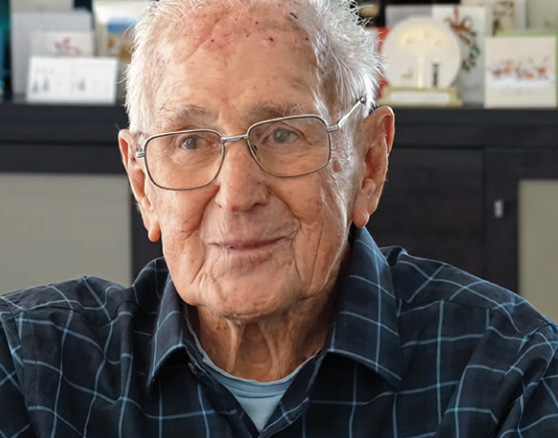
NEW GENERATION
Speaking to Johnson a decade or so after retirement, Ed remarked: “I haven’t exactly lost contact with the industry because my son Glen runs Glen Cameron Trucking.
“His business is mainly local and country transport and storage, operating a mixed fleet of trucks and semi-trailers, with
some very innovative ideas about the co- ordination of trucking with warehousing and storage. “I offer advice and assistance from time to time but Glen is doing very well, so I guess he knows how to run his own show without too much of my help.”
As the interview started to draw to a close, it was perhaps a pensive Ed who asserted: “Personally, I’m glad I’m no longer in the road transport industry. I was deeply involved during the most interesting and exciting period [and], in addition to running trucks, I was also privileged to have a lot of experience in the importing and marketing of Kenworth.
“I wouldn’t want to go back to the 24 hours a day, seven days a week grind with bad roads, hassles with the authorities and, above all, unreliable vehicles that were quite unsuitable for Australian conditions.
“I believe Kenworth brought the manufacturers and importers to the reality that only a truck specced and built for Australian conditions would succeed.”
Then, in a final comment, a staunchly loyal Ed concluded: “Long distance transportation costs in Australia are truly competitive, and industry and the community reap the benefit of fast, economical transport at probably less cost per tonne-mile than anywhere else in the world.
“Having regard to our relatively high wages, fuel and equipment costs, coupled to inferior road conditions, this is quite an achievement.
“For this economy of transport, the Australian public can thank road transport operators, drivers and sub-contractors.”
Almost 40 years after that interview, it’d be more than a tad interesting to know what men of Ed’s era and ilk would think of Australian road transport today.
As for how far Kenworth has come, no one could hold their head higher than Ed – an enterprising truck operator who saw something better, had the initiative to have a go and the drive to make it happen.
